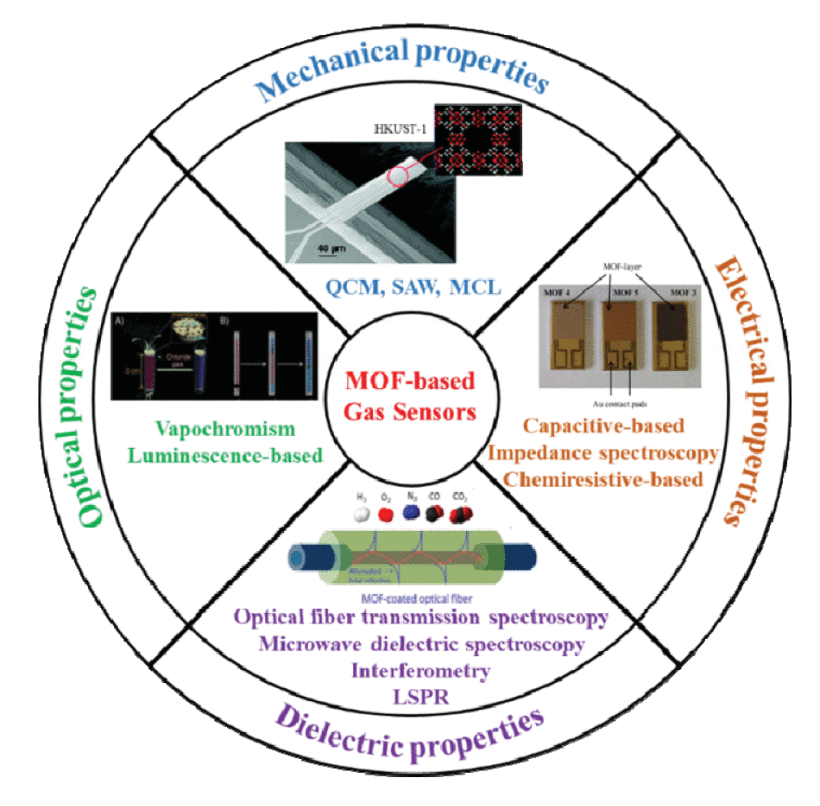Metal-Organic Framework Materials Coupled to Optical Fibers for Chemical Sensing: A Review
Metal-organic frameworks (MOFs) are an emerging class of crystalline materials composed of inorganic metal clusters in coordination with organic ligands. MOFs have ultrahigh porosity, vast internal surface area, and limitless possible combination of structural characteristics. With exceptional tunability, short reaction time, room-temperature operation, storage capacity, good selectivity, reliable reversibility, and repeatability, MOFs present excellent potential for clean energy, gas storage and separation, catalysis, and chemo-sensory applications.
The adsorption of guest molecules by MOF’s open pores produces a discernible change in its inherent electrical, mechanical, optical (refractive index), or dielectric properties. The absorption-induced variations are measured and employed to detect, identify, and quantify the gaseous analytes. Scientists have proposed and characterized several MOF-based chemical sensors based on changes in inherent properties.
The researchers here present an overview and analytical study of recent progress in MOFs as chemosensory materials exploiting the absorption-induced changes in their dielectric and optical properties.
Optical fibers (OF) sensors have long been used in various sensing and monitoring applications. Recently, Optical fiber sensors based on refractive index (RI) variation have gained attention in chemical sensing because of their compact size, high sensitivity, and multiplexing and distributed sensing capabilities.
The RI changes caused by variations in gas concentrations are minimal in traditional OF RI sensors, making them difficult to measure directly. The large surface area and extreme porosity of MOF materials enable them to sponge up a high concentration of analyte, producing larger RI variation. The customizable pore sizes and chemical properties of MOFs also help these sensors selectively respond to a target analyte.
OF-MOF sensors typically use optical sensing techniques like interferometry, evanescent field sensing, transmission spectroscopy, and (localized) surface plasmon resonance. Thin films of MOFs with controlled thickness and surface morphology can be coated onto the surfaces of OF sensors.
Fiber optic interferometry is most widely employed in sensing applications because of its high sensitivity, ease of fabrication, manageable size, and structure. When gaseous molecules from ambiance are absorbed by interferometer layers, their effective RI increases, causing the wavelength shift.
The long period grating (LPG) is another well-known OF RI sensor due to its ultra-high sensitivity to its surroundings. An LPG is a periodic modulation of the RI of the core of a single-mode fiber. The transmission spectrum of the LPG is governed by the effective RI of the MOF thin film coatings, which depends on the concentrations of target chemicals or biological analytes.
For surface plasmon resonance (SPR) spectroscopy, the change due to the analyte is measured as the resonance angle of refracted light. The inherent highly localized and intense electromagnetic field of MOF provides high RI sensitivity making plasmonic OF-MOF hydrogen sensor an attractive choice.
OF-MOF chemical sensors are still in the exploratory stage. Research on OF RI sensing should focus on microfibers and fiber-Bragg gratings, which provide ultra-compactness, tailorable optical confinement, and improved transient fields. With the improvement of MOF thin-film coating technologies, OF-MOF sensors could provide a new class of highly sensitive and selective chemical sensors.




